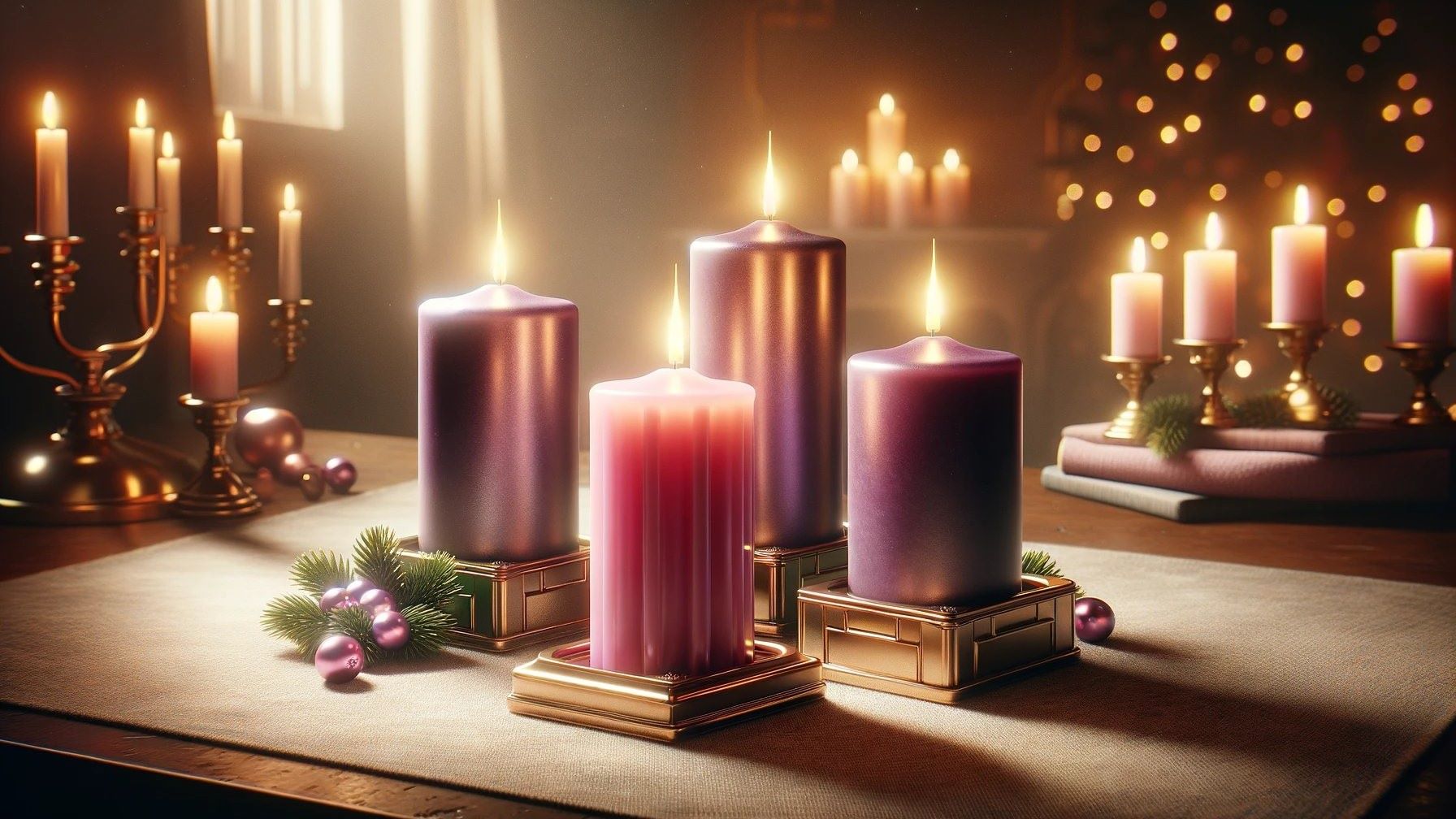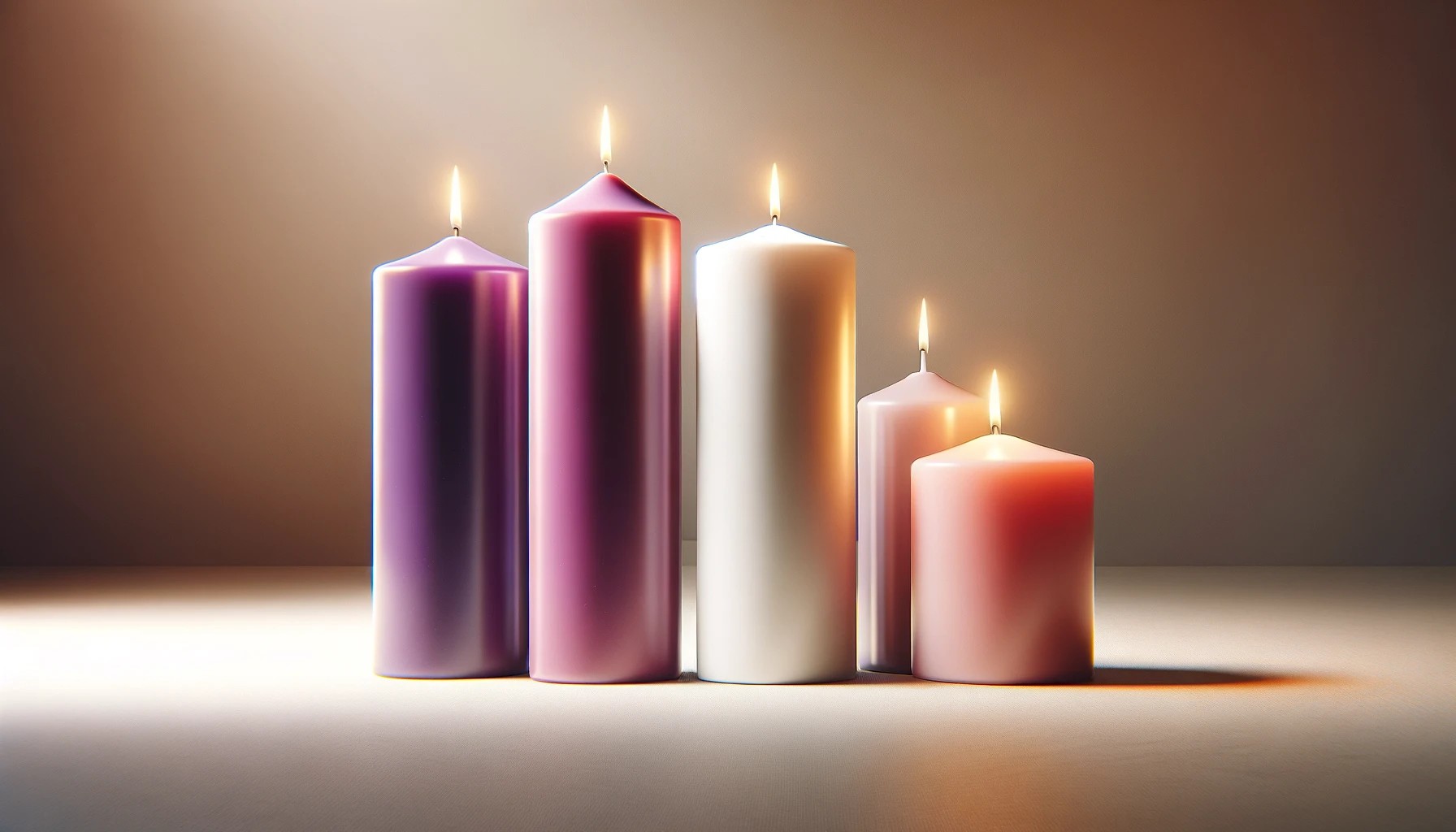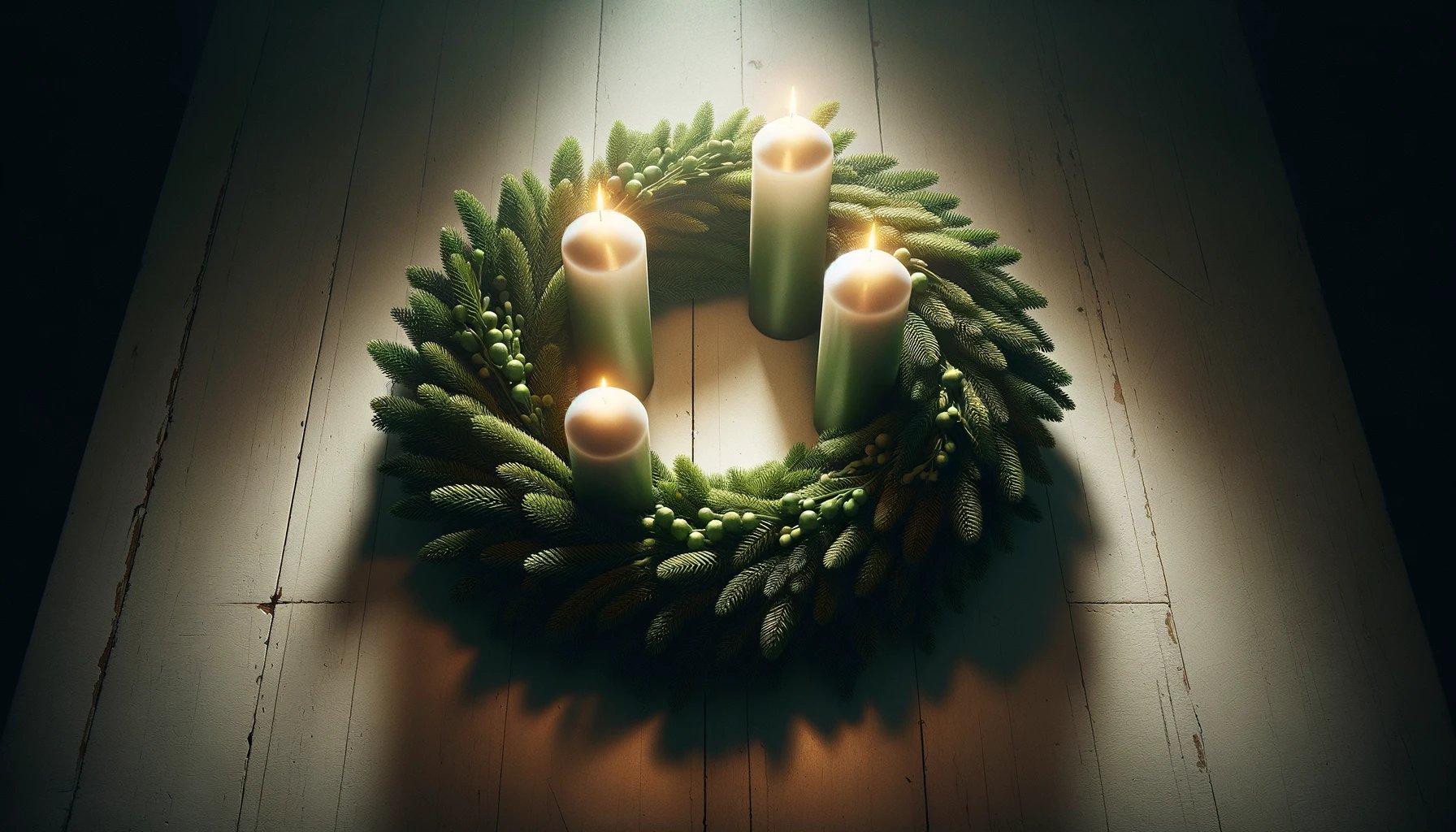Home>Special Themes>How Do The Advent Candles Work


Special Themes
How Do The Advent Candles Work
Published: February 14, 2024
Ericka Andersen, an editor at Christian.net, expertly merges digital strategy with content creation, focusing on faith and societal issues. Her communication skills enhance the platform's engaging narratives, fostering meaningful dialogue on belief's impact on society.
Discover the significance and tradition of Advent candles and how they enhance special themes during the holiday season. Learn how these candles work and their role in celebrating Christmas.
(Many of the links in this article redirect to a specific reviewed product. Your purchase of these products through affiliate links helps to generate commission for Christian.net, at no extra cost. Learn more)
Table of Contents
Introduction
Advent candles are a cherished tradition in many Christian households and churches around the world. These candles play a significant role in the observance of the Advent season, which marks the period of preparation and anticipation leading up to the celebration of Christmas. The lighting of Advent candles is a symbolic and meaningful practice that holds deep spiritual significance for many individuals and communities.
During the Advent season, the lighting of candles serves as a visual representation of the spiritual journey towards the birth of Jesus Christ. Each candle, often arranged in a wreath, symbolizes different aspects of the Advent narrative and carries its own unique significance. As the weeks progress, the lighting of these candles serves as a poignant reminder of the hope, love, joy, and peace associated with the Advent season.
The tradition of using Advent candles dates back centuries and has evolved to encompass various customs and practices across different cultures and denominations. While the specific rituals and meanings associated with Advent candles may vary, the underlying purpose remains consistent: to foster a sense of spiritual reflection, anticipation, and reverence during the weeks leading up to Christmas.
In the following sections, we will delve into the rich history of Advent candles, explore their symbolism, examine the different types of Advent candles, and shed light on the diverse traditions surrounding the use of these candles in various parts of the world. By gaining a deeper understanding of the significance and practices associated with Advent candles, we can appreciate the profound impact they have on the spiritual journey of individuals and communities during the Advent season.
Read more: How Long Do You Light The Advent Candles
History of Advent Candles
The history of Advent candles can be traced back to the early 19th century in Germany, where the tradition of lighting candles during the Advent season began to take shape. Initially, the use of Advent candles was primarily observed within the Lutheran tradition, but it later gained popularity across various Christian denominations.
The concept of using candles to mark the progression of the Advent season is believed to have originated from the medieval practice of counting down the weeks leading up to Christmas. As the tradition evolved, the symbolism of the candles became intertwined with the themes of hope, love, joy, and peace, which are central to the Advent narrative.
The traditional Advent wreath, typically adorned with four candles, became a focal point of the Advent observance. Each candle represents a specific week of Advent, with an additional white candle, known as the "Christ candle," often placed in the center to be lit on Christmas Eve or Christmas Day.
Over time, the use of Advent candles spread beyond Germany and gained prominence in other European countries as well as in North America. The symbolism and rituals associated with the lighting of Advent candles became deeply ingrained in the Advent traditions of many Christian communities, fostering a sense of spiritual contemplation and anticipation during the weeks leading up to Christmas.
The colors of the Advent candles also hold symbolic significance. The traditional colors are purple or blue, representing penitence and preparation, while the third candle, often pink or rose-colored, symbolizes joy. The Christ candle is typically white, signifying purity and the light of Christ.
As the practice of using Advent candles continued to evolve, additional customs and variations emerged, reflecting the diverse cultural and religious expressions within the Christian faith. Today, the lighting of Advent candles remains a cherished and meaningful tradition for countless individuals and families, serving as a tangible reminder of the spiritual journey towards the celebration of the birth of Jesus Christ.
The history of Advent candles is a testament to the enduring significance of this tradition, which continues to enrich the spiritual observance of the Advent season for people of faith around the world.
Symbolism of Advent Candles
The symbolism of Advent candles holds profound significance within the Christian tradition, serving as a visual representation of the spiritual themes and narratives associated with the Advent season. Each aspect of the Advent candles, from their arrangement to their colors and the act of lighting them, carries symbolic meaning that resonates deeply with the faithful.
1. Counting the Weeks of Advent:
The arrangement of the Advent candles in a wreath symbolizes the four weeks of Advent, with each candle representing a specific week leading up to Christmas. This visual depiction of the passage of time serves as a reminder of the journey towards the celebration of the birth of Jesus Christ.
2. Hope, Love, Joy, and Peace:
The four Advent candles are often associated with distinct themes, typically represented by the colors of the candles. The first candle, often purple or blue, symbolizes hope, signifying the anticipation of the coming of Christ. The second candle, also purple or blue, represents love, reflecting the profound love of God manifested through the birth of Jesus. The third candle, often pink or rose-colored, signifies joy, celebrating the imminent arrival of the Savior. The fourth candle, again purple or blue, represents peace, embodying the tranquility and harmony brought by the presence of Christ.
Read more: How Long Do Advent Candles Stay Lit
3. The Christ Candle:
In addition to the four candles representing the weeks of Advent, a central white candle, known as the "Christ candle," is often placed in the middle of the wreath. This candle is lit on Christmas Eve or Christmas Day, symbolizing the arrival of Christ, the Light of the World. The illumination of the Christ candle signifies the culmination of the Advent journey and the joyous celebration of the birth of Jesus.
4. The Light of Christ:
The act of progressively lighting the Advent candles each week symbolizes the increasing anticipation and illumination brought by the presence of Christ. As each candle is lit, the growing light serves as a metaphor for the spiritual enlightenment and hope that Christ brings into the world, dispelling darkness and ushering in a season of joy and renewal.
5. Spiritual Reflection and Anticipation:
Beyond their visual symbolism, the Advent candles invite individuals and communities to engage in spiritual reflection and anticipation. The ritual of lighting the candles fosters a sense of contemplation, encouraging believers to meditate on the profound significance of the Advent season and the transformative impact of Christ's birth.
The symbolism of Advent candles encapsulates the essence of the Advent journey, encapsulating themes of hope, love, joy, and peace while illuminating the spiritual path towards the celebration of the birth of Jesus. This visual and symbolic tradition continues to resonate deeply with individuals and communities, serving as a poignant reminder of the enduring significance of the Advent season within the Christian faith.
How Advent Candles are Used
The use of Advent candles is a central and cherished practice during the Advent season, serving as a poignant and symbolic ritual that engages individuals and communities in spiritual reflection and anticipation. The manner in which Advent candles are used encompasses various customs and traditions, each contributing to the rich tapestry of the Advent observance.
Read more: What Do Advent Wreath Candles Represent
1. Lighting the Candles:
The lighting of Advent candles typically takes place on each Sunday of the Advent season, beginning with the first Sunday, which marks the start of the liturgical year in many Christian traditions. As each week of Advent progresses, an additional candle is lit, symbolizing the incremental journey towards the celebration of Christmas. The act of lighting the candles is often accompanied by prayers, readings, and hymns that correspond to the themes of hope, love, joy, and peace, reinforcing the spiritual significance of each candle.
2. Family and Community Observance:
In many households and congregations, the lighting of Advent candles is a communal activity that brings families and communities together. Whether in the intimate setting of a family home or the shared space of a church sanctuary, the ritual of lighting the Advent candles fosters a sense of unity and shared devotion. This collective observance serves as a reminder of the broader community of faith and the interconnectedness of individuals on their spiritual journey.
3. Advent Wreath as a Symbolic Centerpiece:
The arrangement of the Advent candles within a wreath holds symbolic significance, with the circular shape representing eternity and the evergreen foliage symbolizing the enduring nature of God's love and faithfulness. The Advent wreath serves as a visual centerpiece, anchoring the observance of the Advent season and providing a focal point for reflection and contemplation. As the candles are progressively lit, the wreath becomes a tangible representation of the passage of time and the growing anticipation of Christ's birth.
4. Personal Devotion and Meditation:
Beyond communal observance, the use of Advent candles also extends to personal devotion and meditation. Many individuals incorporate the lighting of Advent candles into their daily spiritual practices, using the visual symbolism of the candles to guide their personal reflections on the Advent themes. The gentle glow of the candles serves as a source of comfort and inspiration, creating a sacred space for quiet contemplation and prayer.
Read more: How To Use Advent Candles
5. Educational and Inspirational Tool:
For children and individuals new to the Advent tradition, the use of Advent candles serves as an educational and inspirational tool. The visual and tactile elements of the candles, combined with the accompanying readings and discussions, provide a multi-sensory experience that engages individuals of all ages in the Advent narrative. This interactive approach helps to impart the spiritual significance of the Advent season and instill a sense of anticipation and wonder in participants.
The utilization of Advent candles encompasses a multifaceted approach, blending communal observance, personal devotion, and educational engagement to create a holistic and enriching experience. Through the intentional use of Advent candles, individuals and communities are invited to embark on a transformative spiritual journey, embracing the timeless themes of hope, love, joy, and peace as they prepare their hearts for the celebration of the birth of Jesus Christ.
Types of Advent Candles
The diverse array of Advent candles reflects the rich tapestry of traditions and expressions within the observance of the Advent season. From traditional wax candles to modern interpretations, the types of Advent candles available cater to a wide range of preferences and cultural contexts. Each type of Advent candle carries its own unique characteristics, adding depth and variety to the visual and symbolic representation of the Advent journey.
-
Traditional Wax Candles:
Traditional wax candles, often adorned with the classic Advent colors of purple, pink, and white, remain a popular choice for many individuals and congregations. These candles, typically designed to fit into an Advent wreath, embody the timeless elegance and simplicity of the Advent tradition. The act of lighting these candles evokes a sense of continuity with historical practices while infusing the observance with a timeless and reverent ambiance. -
LED Advent Candles:
In contemporary settings, LED Advent candles have emerged as a practical and versatile alternative to traditional wax candles. These electronic candles, often equipped with flickering LED lights, offer the convenience of reusable and flameless illumination. LED Advent candles are particularly well-suited for environments where open flames may not be suitable or for individuals seeking a more sustainable and long-lasting option for their Advent observance. -
Decorative Artisan Candles:
Artisan-crafted Advent candles showcase a creative and personalized approach to the Advent tradition. These candles, often handcrafted with intricate designs and embellishments, serve as unique works of art that add a touch of individuality and creativity to the Advent wreath. Artisan candles provide an opportunity for individuals to incorporate their personal aesthetic preferences and artistic sensibilities into the visual representation of the Advent season. -
Scented Advent Candles:
Scented Advent candles offer a multi-sensory dimension to the Advent observance, infusing the surrounding space with evocative aromas that complement the spiritual themes of the season. Whether imbued with fragrances reminiscent of evergreen forests, warm spices, or floral notes, scented Advent candles create an immersive and sensory-rich experience that enhances the ambiance of the Advent wreath and fosters a deeper connection to the season's significance. -
Customized Advent Candles:
For those seeking a personalized touch, customized Advent candles provide a means of tailoring the visual and symbolic elements of the Advent tradition to individual preferences. Whether through personalized engravings, bespoke color combinations, or custom-made designs, these candles offer a unique avenue for individuals and families to imbue their Advent observance with personal meaning and significance.
The diverse array of Advent candles reflects the evolving nature of the Advent tradition, accommodating a spectrum of preferences and interpretations while upholding the timeless themes and symbolism of the season. Regardless of the type chosen, each Advent candle contributes to the visual tableau of the Advent wreath, enriching the spiritual journey towards the celebration of the birth of Jesus Christ.
Lighting and Extinguishing Advent Candles
The ceremonial lighting and extinguishing of Advent candles are integral components of the Advent observance, each carrying its own symbolic significance and ritualistic practices. These actions, performed with reverence and intentionality, serve to mark the progression of the Advent season and imbue the observance with a sense of spiritual contemplation and anticipation.
Lighting the Advent Candles
The act of lighting the Advent candles is a deliberate and ceremonial practice that unfolds over the course of the four weeks leading up to Christmas. Each Sunday of Advent, a new candle is lit, symbolizing the incremental journey towards the celebration of the birth of Jesus Christ. The lighting of the candles typically takes place in conjunction with prayers, readings, and hymns that correspond to the specific theme represented by the candle being lit. This intentional pairing of visual symbolism with auditory and verbal expressions reinforces the spiritual significance of the Advent themes and fosters a multi-sensory experience for participants.
As the first candle, symbolizing hope, is lit on the initial Sunday of Advent, it serves as a poignant reminder of the anticipation and expectation associated with the arrival of Christ. Subsequent Sundays see the lighting of the love, joy, and peace candles, each building upon the spiritual narrative and infusing the observance with a deepening sense of purpose and reverence. The gradual illumination of the Advent wreath mirrors the increasing anticipation and illumination brought by the presence of Christ, creating a visual representation of the spiritual journey towards Christmas.
Read more: How To Light The Advent Candles
Extinguishing the Advent Candles
In contrast to the progressive lighting of the candles, the extinguishing of the Advent candles marks the culmination of the Advent season and the transition into the joyous celebration of Christmas. The Christ candle, often placed in the center of the wreath, is typically lit on Christmas Eve or Christmas Day, signifying the arrival of Christ, the Light of the World. This act of illumination represents the fulfillment of the Advent journey and the dawning of the long-awaited moment of Christ's birth.
Following the lighting of the Christ candle, the remaining Advent candles are extinguished, symbolizing the completion of the Advent observance and the commencement of the Christmas celebration. The gentle act of extinguishing each candle serves as a solemn yet hopeful gesture, encapsulating the transition from anticipation to fulfillment and underscoring the transformative significance of Christ's birth.
The lighting and extinguishing of Advent candles form a poignant and symbolic ritual that encapsulates the spiritual journey of the Advent season, guiding individuals and communities through a period of reflection, anticipation, and ultimately, celebration. This timeless tradition continues to resonate deeply with those who seek to engage in a meaningful and contemplative observance of the Advent season.
Advent Candle Traditions around the World
The observance of Advent candle traditions transcends geographical boundaries, encompassing a diverse tapestry of customs and practices that reflect the rich cultural and religious expressions of communities around the world. From Europe to the Americas, Africa to Asia, the use of Advent candles has been woven into the fabric of local traditions, infusing the observance of the Advent season with unique regional flavors and interpretations.
In Germany, the birthplace of the Advent candle tradition, the lighting of Advent candles holds a central place in the pre-Christmas festivities. Families gather around the Advent wreath, often adorned with four candles and seasonal greenery, to mark the progression of the Advent season. The ritual of lighting the candles is accompanied by the singing of traditional hymns and the sharing of reflective readings, fostering a sense of communal anticipation and spiritual contemplation.
In Scandinavian countries, the observance of Advent is characterized by the use of Advent candles to illuminate the dark winter nights. Families light Advent candles as a symbol of hope and light amidst the seasonal darkness, creating a warm and inviting atmosphere within their homes. The candles, often placed in decorative candle holders, serve as a visual reminder of the approaching Christmas season and the promise of renewal.
In Latin American cultures, the tradition of lighting Advent candles is intertwined with vibrant and colorful celebrations. The observance of Advent often incorporates elements of indigenous customs and Catholic traditions, resulting in a rich tapestry of rituals and festivities. The lighting of Advent candles is accompanied by lively music, festive decorations, and communal gatherings, creating a joyous and spirited atmosphere that permeates the Advent season.
In African communities, the use of Advent candles is often integrated into the fabric of local worship and spiritual practices. The observance of Advent is marked by the lighting of candles in churches and homes, accompanied by prayers, songs, and storytelling that reflect the cultural heritage and spiritual resilience of the community. The symbolism of the Advent candles resonates deeply with the themes of hope, love, joy, and peace, serving as a source of inspiration and encouragement during the Advent season.
In Asia, the observance of Advent candles reflects the diverse religious and cultural landscape of the region. Christian communities incorporate the lighting of Advent candles into their worship services and personal devotions, infusing the observance with elements of local customs and traditions. The use of Advent candles serves as a unifying symbol of faith and anticipation, bridging diverse cultural backgrounds in the shared celebration of the Advent season.
The global tapestry of Advent candle traditions showcases the enduring significance of this timeless practice, demonstrating its ability to resonate with individuals and communities across different continents and cultural contexts. Whether in the frosty winters of Europe, the festive rhythms of Latin America, the spiritual landscapes of Africa, or the diverse tapestry of Asia, the observance of Advent candles serves as a unifying thread that weaves together the shared anticipation and joy of the Advent season.
The global tapestry of Advent candle traditions showcases the enduring significance of this timeless practice, demonstrating its ability to resonate with individuals and communities across different continents and cultural contexts. Whether in the frosty winters of Europe, the festive rhythms of Latin America, the spiritual landscapes of Africa, or the diverse tapestry of Asia, the observance of Advent candles serves as a unifying thread that weaves together the shared anticipation and joy of the Advent season.
Conclusion
The observance of Advent candles transcends mere tradition; it embodies the timeless themes of hope, love, joy, and peace that resonate deeply within the hearts of individuals and communities around the world. From its origins in 19th century Germany to its widespread embrace across diverse cultural and religious landscapes, the use of Advent candles has evolved into a cherished and meaningful practice that enriches the spiritual observance of the Advent season.
The history of Advent candles reflects a journey of spiritual continuity and adaptation, as the tradition has endured and flourished across generations and geographical boundaries. The symbolism of the Advent candles, from the arrangement of the wreath to the colors and the act of lighting and extinguishing, serves as a visual and tactile expression of the profound narrative of the Advent season. This symbolism invites individuals to engage in spiritual reflection, fostering a sense of anticipation and reverence as they prepare their hearts for the celebration of the birth of Jesus Christ.
The diverse array of Advent candles, ranging from traditional wax candles to modern interpretations, offers a spectrum of choices that cater to individual preferences and cultural contexts. Whether through the timeless elegance of traditional candles or the innovative versatility of LED and scented options, each type of Advent candle contributes to the visual tableau of the Advent wreath, enriching the spiritual journey towards Christmas.
The observance of Advent candle traditions around the world showcases the universal appeal and adaptability of this practice, as it seamlessly integrates with local customs and cultural expressions. From the festive gatherings in Latin America to the spiritual resilience in African communities, the use of Advent candles serves as a unifying symbol of faith and anticipation, bridging diverse cultural backgrounds in the shared celebration of the Advent season.
In essence, the observance of Advent candles is a testament to the enduring significance of the Advent season within the Christian faith. It invites individuals and communities to embark on a transformative spiritual journey, embracing the timeless themes of hope, love, joy, and peace as they prepare their hearts for the celebration of the birth of Jesus Christ. As the gentle glow of the Advent candles illuminates homes and sanctuaries, it serves as a tangible reminder of the enduring light of Christ and the promise of renewal and redemption that the Advent season embodies.











